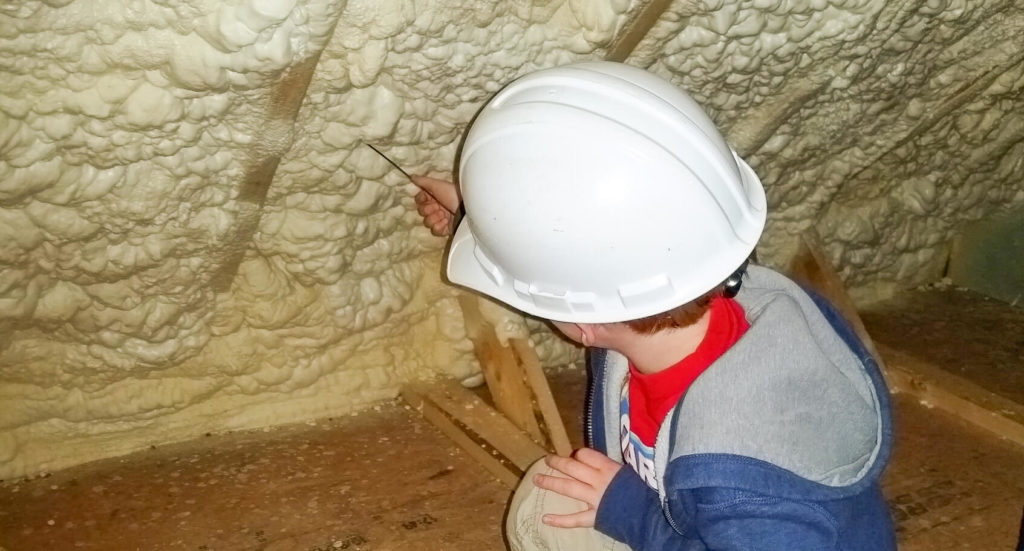Spray Foam and Code Compliance – What Are Your Options?
- Last Updated Oct. 27, 2023
- 6 Minute Read
Originally Published July 15, 2019

Originally Published July 15, 2019

And the award for “Most Affected by Code Changes” goes to… spray foam! 👏 When this blog was first published in 2019, we received a ton of questions about sealed attics and spaces — or more specifically, panicked requests to get open-cell spray foam roof decks passing for code — when in the previous year it was not an issue. Fast forward to current times, there is still quite a bit of confusion about what is needed and why. If this sounds like you, check out the information below for details on the issue and learn about options to keep your projects on track.

Open-cell spray foam, typically used to insulate the roof deck to create a sealed attic space, is most commonly applied at a depth of 5.5”. With an average R-value of 3.7 per inch, the ceiling assembly averages an R21, not quite meeting the R38 ceiling insulation code requirement. REScheck – a free DOE software program that automates IECC insulation and window trade-off calculations – was the go-to solution for insulation contractors to be able to demonstrate code compliance.
Unfortunately, the DOE decided not to provide a REScheck software update to include the 2018 NC Energy Conservation Code (NCECC). On January 1st, 2019 when our 2018 NCECC went into effect, insulation contractors no longer had a NC code specific option to provide code officials. Now the closest available REScheck option references the 2015 IECC – a more stringent code – creating a hitch in the giddy-up of spray foam land.
The 2018 NCECC requires R38 ceiling assemblies — no change for Climate Zone 4 and a small change for Climate Zone 3. While there are other performance related code changes, as long as you are meeting the prescriptive R-value requirements for walls, ceilings, windows, and floors you will be fine with any type of insulation and do not need to provide additional documentation to code officials. If you want to insulate the roof deck with open-cell spray foam at 5.5”, you will need to provide a trade-off calculation report.
| *Table R402.1.2 | 2018 NCECC | 2015 NCECC |
|---|---|---|
| Ceiling R-Value | 38 | 49 |
| Wall R-Value | 15 | 20 |
| Window U-Value | 0.35 | 0.35 |
| Floors R-Value | 19 | 19 |
| Foundations R-Value | 10/15 | 10/13 |
When insulation levels do not meet the prescriptive 2018 NC Energy Code requirements, the NC DOI lists 4 alternative methods to demonstrate energy code compliance:
The first two reporting methods are the best options for evaluating open cell spray foam for 2018 NC Energy Code compliance. RESNET approved Home Energy Modeling software has the ability to perform the trade-off calculations, and generate reports that are specific to the 2018 NCECC. Check out our quick guide to Energy Code Compliance Pathways here →
To generate an energy model of your project, a HERS rater (that’s us!) will need a full set of plans – at minimum floor plans, elevations, and window schedules – as well as your insulation and mechanical specs. If you are already getting HERS ratings for your homes, your HERS rater should be able to produce the reports without any additional information needed from you.
This report evaluates the thermal properties of the full building envelope and allows for trade-offs between ceiling, wall, floor, foundation, door, and window thermal properties. We have found that windows can be the deciding factor here if all other building envelope components are spec’d at code minimum. If a home does not pass under the UA evaluation, the next step is the performance evaluation.
This report evaluates whole home energy use, expanding the trade-off criteria to anything that impacts the energy use of the home, such as HVAC equipment, water heating, air-tightness, duct-tightness, orientation, etc. If homes still do not pass based on performance, the Energy Rater can evaluate options to help you determine the most cost-effective upgrades to get the home to pass.
The Total UA Compliance Report is readily accepted by code officials straight from the HERS Modeling software. An engineer / architect’s stamp is required for the 2018 Performance Compliance Report, and they typically charge a nominal fee to provide their stamp.
Ready to get started? We can help! Send your building plans to Justin for review: jwhaley@southern-energy.com
Options 3 and 4 are not well suited for open-cell spray foam situations. The ERI approach can be a great method to demonstrate full energy code compliance, but since it currently requires that insulation meet prescriptive code R-values, it is not helpful where spray foam trade-off calculations are needed. The 2015 IECC has more stringent insulation R value requirements than the 2018 NCECC, so while you can still use the REScheck software to perform the trade-off calculations, open cell spray foam at 5.5” will most likely not pass in a 2015 IECC comparative report.
And here we find the child left behind – 3rd floor / finished attic renovations. Unfortunately, there is currently not a 2018 NC Energy Code trade off report option designed for partial renovations.
If a full set of plans is available for the project, there is a chance that the HERS energy modeling software might be able to help, but since it is designed to evaluate whole buildings, not partial structures, we have found that it is not applicable in many cases. To produce the Total UA or Performance reports, the software requires building envelope inputs for foundation, walls, windows, and ceilings, as well as basic mechanical system specs. Even when this information is available, the trade-off options are more limited since much of the home is not part of the renovation.
So what are renovation projects to do? Currently we are evaluating projects on a case by case basis to see if energy modeling is an option. REScheck does provide a pathway to evaluate partial renovations, but similar to new construction, the comparison for the evaluation report is the 2015 IECC.
If you are an insulation contractor or builder aware of additional resources for renovation projects, we’d love to hear from you to help spread the word.
If you are considering or are applying open-cell spray foam, we can utilize our energy modeling to see if your current spray foam levels will pass free and clear (UA Report), or if it will need an engineer’s stamp (Performance Report), or if you will need to consider upgrading insulation levels or seek other trade-offs. If you have any additional questions, please let us know!
Schedule a meeting to review your home performance goals and challenges.
North Carolina’s solar power and building performance expert. Founded in 2001, we’ve worked for 20+ years to improve the way people make and use energy.